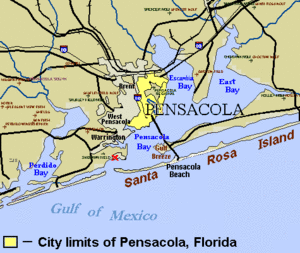Presidio Santa Maria de Galve facts for kids
The Presidio Santa María de Galve was an important Spanish settlement. Spanish colonists built it in 1698. It was the first European settlement in Pensacola, Florida, after an earlier one in the 1500s.
This presidio (a type of fort or military base) was located near where Fort Barrancas is today. This area is now part of Naval Air Station Pensacola in northwestern Florida. The Presidio Santa María de Galve included a fort called Fort San Carlos de Austria and a small village next to it.

Contents
Why the Spanish Built the Presidio
In the late 1600s, France started expanding its control down the Mississippi River. This made the Spanish government worried. They wanted to protect their lands along the northern coast of the Gulf of Mexico.
To do this, the leaders of New Spain decided to build the Presidio Santa María de Galve. It was built in 1698. Its main job was to protect the western parts of Spanish Florida. At that time, Spanish Florida stretched from the Atlantic coast to the Apalachicola River.
Battles and Changes in Control
The French threat became real very quickly. France built Fort Maurepas in 1699, near what is now Biloxi, Mississippi. Then, they built Mobile in 1702.
In August 1707, English forces from the Province of Carolina and their Tallapoosas allies attacked the settlement. The village was burned down. The Spanish managed to hold onto the fort. They also defended it when it was attacked again in November.
The Tallapoosas, with English help, kept attacking the fort for eight years. They raided the area and captured more than 70 Spanish people found outside the fort. In 1715, the Tallapoosas stopped working with the English. They became friends with the Spanish at Fort San Carlos de Austria. After the attacks ended, a new village was built.
In May 1719, during a war called the War of the Quadruple Alliance, the French attacked Santa María de Galve. The Spanish gave up Fort San Carlos de Austria after a five-hour battle. The Spanish took the fort back in August of that year. But they lost it to French forces again the very next month.
The French held the presidio for three years. In 1722, a treaty returned the area around Pensacola Bay to Spain. Before leaving, the French burned the fort and village.
After losing Santa María de Galve in 1719, Spain moved its government for West Florida. They moved it to a new fort called Presidio Bahía de San José. This new fort was on the northern end of the St. Joseph Peninsula. When the Spanish returned to the Pensacola area in 1722, they did not rebuild at the old site. Instead, they built a new presidio called Presidio Isla Santa Rosa Punta de Sigüenza on Santa Rosa Island.
Fort San Carlos de Austria: A Closer Look
The main part of the presidio was Fort San Carlos de Austria. It was a large square fort, about 100 by 100 varas (a vara is a Spanish unit of length, a bit less than a meter). The fort's walls were three varas high. A moat, about 3.3 feet (1 meter) deep, surrounded the fort.
The fort's walls were first made from pine logs laid flat. Sand filled the space between the inner and outer walls. But the humid climate and constant contact with sand made the logs rot quickly. By 1707, most of the fort walls had to be replaced with logs standing upright.
The settlement was hit by several hurricanes during its 20 years of existence. These storms caused the land below the fort to wear away. This meant the fort needed constant repairs to stay strong. The wall on the south side, closest to the water, was eventually rebuilt further back. This made the fort's shape a bit uneven.
Buildings Inside the Fort
Inside the fort, there were several important buildings. These included a church, a hospital, a warehouse, the governor's house, and three barracks. One barracks was for officers, one for soldiers, and one for convict laborers.
There was no local stone for building, and no brick factories. So, all the buildings were made of wood. At first, the walls and roofs were made of palmetto thatch. Later, the more important buildings got roofs made of lead sheets or shingles, and walls made of wooden planks. Some buildings had solid floors, while others had dirt floors.
Archaeologists from the University of West Florida have studied the site of Santa Maria de Galve. They have learned a lot about this historic Spanish settlement.
See also
 In Spanish: Presidio Santa María de Galve para niños
In Spanish: Presidio Santa María de Galve para niños


